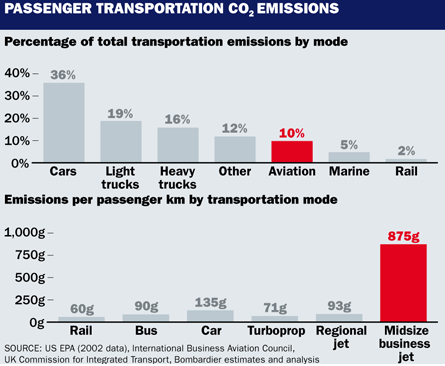Carbon offsets are dismissed by some critics as an excuse for individuals and corporations to carry on with bad behaviour rather than implement real change to reduce greenhouse gas emissions. But ask Bombardier how it views such programmes and it will tell you plainly that carbon offsetting is part of a new environment-driven reality that airframers and operators are going to have to build into their business models.
Closing fast are European Union plans to include in its Emissions Trading Scheme all flights arriving or departing from airports in the EU. The ETS is a "cap and trade" scheme by which total industrial emissions will be capped at 2004-6 levels. Amounts above this level must be offset or traded.
Implementation is fast approaching, notes Bombardier. This August, operators must submit their plans for pre-compliance to the EU member state government where their aircraft is domiciled or flies the most. In January 2010, a two-year pre-compliance period begins with required reportage in preparation for January 2012, when the ETS becomes operational for aviation.
 |
|---|
WRITING ON THE WALL
The USA has warned Europe to expect an international legal challenge as soon the scheme is built into national law. However, Bombardier sees the writing on the wall, and is looking at how "completely new services like a carbon offset programme" can be incorporated into its fleet management initiatives, says Michael McAdoo, vice-president, fleet management for Bombardier Customer Services.
He points out that Bombardier's Pratt & Whitney PW1000G-powered CSeries, which is expected to enter service in 2013, is the airframer's first new commercial platform that offers fleet management "literally inherent with the design of the aircraft".
The company already has experience in managing carbon offsets. On 1 February 2008, Bombardier introduced a voluntary scheme in partnership with UK-based carbon-offset seller ClimateCare, whereby owners can offset the annual carbon emissions from their business aircraft based on average operating hours for each aircraft type.
At the top of the food chain is the Global Express line, which can be offset at a current price per flight hour of just over $71. The price tag to carbon-offset Challenger jets ranges from $41.11 for the Challenger 300 to $70.04 for the Challenger 870CS. All types in the Learjet line, apart from the Learjet 25D, 35A and 60 XR, can be offset for less than $30 per flight hour.
Using the same monthly billing system currently employed for Bombardier's Smart Services per flight-hour programmes, such as Smart Parts and Smart Maintenance, aircraft owners report the total monthly flight-hours of the aircraft enrolled. The money is then invested in low-carbon technology projects that focus on renewable energy, energy efficiency and methane capture.
Bombardier acknowledges that while business aviation contributes just 1%-1.5% of total aviation emissions, per-passenger CO2 emissions for the midsize business jet sector soar high above per-passenger emissions from other forms of transport (see chart).
Still, it is the aviation industry as a whole that must face radical changes in environmental law.
Air Transport Action Group executive director Paul Steele summed up the CO2 situation at last month's Aviation and the Environment Summit in Geneva. This year, he said, "is an absolutely critical year, not just for society in general but certainly for our industry".
Stressing the prevailing sense of urgency, he added: "It appears to me that the industry has probably got three or four months to really take a role and try and get around how it can help craft its own destiny in these discussions and that's something we shouldn't dismiss lightly, something that we really should keep in our mind.
"Because next year, or the year after, when we reconvene at the Aviation and the Environment Summit, those political dies will already have been cast, and as an industry we will be operating under a new framework. And I think that is a sobering thought for all of us to take home."
Source: Flight International























